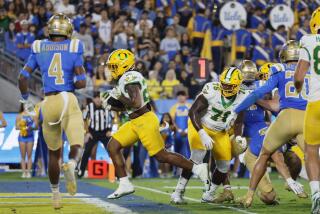Truth Be Told, Disclosure of Injuries Protects Schools
- Share via
It was a Rose Bowl miracle.
Or should we say miracles?
Stanford defensive tackle Willie Howard, the Cardinal’s best player against the run, tears a ligament in his right knee, not a trivial injury, in the final regular-season game against Notre Dame and, according to a press release issued by the university’s sports information department, will be “unavailable” for the Rose Bowl game.
On Tuesday before the game, Stanford wide receiver Troy Walters, the Cardinal’s best player, dislocates his right wrist during practice, and, according to another press release issued by the university’s sports information department, is “out” of the Rose Bowl game. Within 48 hours of the game, he is telling reporters that he might watch from the press box with offensive coordinator Bill Diedrick.
So who do you think is on the field Saturday in Pasadena, playing as hard, and almost as well, as ever as the Cardinal comes within a touchdown and a couple of bad snaps of overcoming substantial odds in a 17-9 loss to Wisconsin?
Howard and Walters.
Ron Dayne, the Badgers’ Heisman Trophy winner, still runs for 200 yards and scores a touchdown, but it could have been worse--ask UCLA, which let Dayne rumble for 246 yards and four touchdowns in last year’s Rose Bowl game--if not for Howard’s play at the line.
Walters, who quickly establishes himself as more than a decoy when he becomes the target of quarterback Todd Husak’s second pass, catches three in the first half for 52 yards, including one for 28 that leads to the Cardinal’s first score, a field goal, and one for 19 that leads to the Cardinal’s only touchdown.
“Willie and I were talking earlier this week, saying that we were going to surprise everyone by going out there and playing,” Walters says later. “That’s the character of this team, to overcome hurts and obstacles.”
This is a wonderful story, isn’t it?
*
Well, yes and no.
One problem is that I’m not sure exactly what the story is.
Did Howard and Walters find out that the Rev. Benny Hinn, the man credited by Evander Holyfield for laying hands on him and curing his heart disease, was appearing in Long Beach on Friday night and pay him a visit?
Are Stanford’s team doctors so advanced that they can heal injuries that force players on other teams to the sidelines?
Or was someone, Stanford Coach Ty Willingham for example, playing fast and loose with the truth in discussing the severity of the injuries to Howard and Walters?
Willingham almost certainly did after Walters hurt his wrist Tuesday, reporting to Stanford’s sports information department that night, in response to media inquiries, that there was no injury. About 12 hours later came the release declaring Walters out of the game as a result of that non-injury.
But I have been assured by those who know Willingham better than I that he is not a duplicitous person. So let’s give him the benefit of the doubt and assume that the stories are exactly as Howard and Walters told them after the game.
“I knew for awhile that I would be given an opportunity to play,” Howard said. “I didn’t know how much or whether I’d start. But once I got out there, I just kept going.”
Walters said he knew Thursday afternoon, after Stanford doctors discussed his situation with colleagues in the NFL and were assured that he could not further damage the wrist, that he also would be given a chance to play.
Willingham hinted at the possibility of that during his press conference Friday, but he said nothing definitively--except that he’s glad he isn’t bound by the same rule as NFL coaches requiring them to fully disclose the injury status of their players.
*
I hope Willingham will reconsider that.
All coaches would prefer to conceal as much about their teams, including injuries, especially injuries, as possible. But the NFL rule actually protects the coaches, players and everyone else involved in the game.
The NCAA should adopt it.
The primary reason that the rule exists is to give oddsmakers as much information as they need to set a betting line. The bettors trust that and, as a result, don’t go seeking that kind of information on their own.
I guarantee Willingham that the last thing he wants is for some of those guys to start lurking outside his practices or the dorms to find out about injuries because they don’t believe he’s on the level. That’s asking for a scandal.
If it can happen at Northwestern, it can happen at Stanford.
*
Randy Harvey can be reached at his e-mail address: randy.harvey@latimes.com.
More to Read
Go beyond the scoreboard
Get the latest on L.A.'s teams in the daily Sports Report newsletter.
You may occasionally receive promotional content from the Los Angeles Times.










